|
|
Your Details
|
|
Your Details
|
Reviewed By Andreas Zabczyk
May and Ancient Greek Jewelry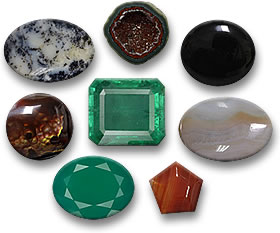 Birthstones for May, Emerald and Agate
May and Greek Goddess MaiaThe month of May is thought by some to be named after the Greek goddess, Maia, (the Roman goddess of fertility, Bona Dea). In Greek mythology, Maia was the daughter of Atlas and the mother of Hermes, Zeus's son. Maia was often depicted as a nursing mother and was associated with the Earth. Maia was the eldest of the Pleiades (the seven stars, also known as the Seven Sisters, which can be seen in the night sky to this day, in the constellation of Taurus). She was said to be a shy goddess who lived in a cave. In addition to her own child, Maia cared for a child called Arcas, whose mother had been turned into a bear. Indeed, the word "Maia" means "great one", "increase", "mother" or "midwife". It seems fitting that for many nations around the world, Mother's Day falls during the month of May. Ancient Greek AdornmentsThe ancient Greeks took pride in their appearance, and treasured athleticism. Evidence of this can be seen in the establishment of the Olympic Games and ancient Greek art, where the beauty of the male and female body was reproduced with wonderful accuracy and in minute detail. 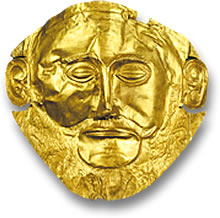 Gold Mycenaean Funeral Mask
The success of Greek society allowed the ancient Greeks to pay attention to art and decorations, such as jewelry, which was a status symbol worn by the wealthy. Ancient Greek jewelry designs began with simple beads before the Bronze Age allowed more elaborate pieces to be made. The Minoans, who inhabited Crete, imported tin (which was used to make bronze alloys), gemstones, silver and gold. The Minoans were skilled jewelry designers. After the conquests of Alexander The Great, gold and other precious materials became more widely available to the ancient Greeks. Although the expansion of the Greek Empire ultimately led to its downfall, the Hellenistic Period saw the Greek Empire at its zenith and this is the time when Greek art was most prolific. The art produced during Hellenistic Greece influenced the world for centuries thereafter. Indeed, the Italian Renaissance shows aspects of ancient Greek art, as do Asian Buddha images. Ancient Greek Head Jewelry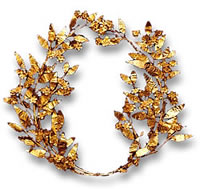 Ancient Greek Gold Myrtle Wreath
The ancient Greeks used a variety of jewelry items, such as earrings, brooches, torques, hair decorations, bracelets and rings. However, one of the most characteristic ancient Greek jewelry designs was the wreath or crown. Wreaths were horseshoe-shaped or complete circles, which signify eternity. The Greek word, stephanos means "crown" or "wreath". The meaning of ancient Greek wreaths made from plants, such as laurel, myrtle and oak are associated with Greek gods and goddesses. The myth of Daphne and Apollo tells the story of Daphne being turned into a laurel tree. From that time on, her lover, Apollo, wore a laurel wreath as a symbol of unrequited love. The laurel wreath also symbolized eternity, peace and victory. In ancient Greece, wreaths were worn to show status (as can be seen on crowned figures shown on ancient Greek coins) or victorious achievements, such as the winning athletes at the Olympic Games. Crowns are still worn in Greece, by the bride and groom during weddings. It is said that the circular crown is a symbol of female power, embodied by Mother Nature. 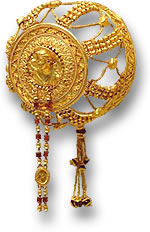 Gold and Garnet Hairnet
Golden Hairnets and ArmletsSome of the most elaborate ancient Greek gemstone jewelry pieces were necklaces, earrings and hairnets. When we think of modern hairnets, they do not suggest opulence or beauty. But ancient Greek golden hairnets were objects of extreme luxury, intricately made from gold and sometimes featuring gemstone beads such as garnets, (see image, left). Armlets are another jewelry item that was widely worn by the ancient Greeks. Like golden hairnets, these are not so often seen in modern society. These were worn around the biceps of the upper arm and were usually matching pairs. Popular motifs were animal heads, gods and goddesses, and serpents. Also worn were thigh bands, bracelets and anklets. Some of these had gemstone, goddess or animal head finials. Ancient Greek RingsEngraved rings were popular in ancient Greece and were used as conveniently portable seals. Such signet rings were also made from gemstones, such as garnet, carnelian and precious metals (see, image below). These tended to be bezel-set cabochons. 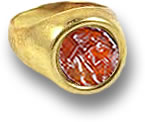 Ancient Greek Carnelian Signet Ring
An interesting ancient Greek ring is known as the "Theseus Ring". It is a gold signet ring from the late Bronze Age that was discovered in Athens in the 1950s. The ring is engraved with a Minoan bull-leaping scene, flanked by a lion and a tree. After it was first unearthed, the ring was widely believed to have been a fake. However, archeologists later confirmed it to be an authentic artifact. According to the Greek legend, Theseus, the son of Aegeus, was a hero credited with slaying a frightful part-bull and part-man monster, known as the Minotaur, that devoured children and lived in a Labyrinth in Crete. In another story, Theseus retrieves a ring from the bottom of the sea to prove his divine parentage to a disbelieving Minos. Either this or the bull-leaping scene caused the ring to be named after the mythological character. Ancient Versus ModernIf you are a fan of gold, ancient Greek fashion may be just your thing. Ancient Greek golden jewelry can make an ordinary person feel like an Adonis or an Aphrodite. If gold does not suit your taste, similar pieces can be made in silver, for a modern twist. Contemporary Greek style uses the ancient motifs, such as leaves, serpents or engravings, and presents them in a new way, with mixed metals and interesting gemstones. We hope that this article inspires you to create some unique jewelry that incorporates the Grecian style. |
